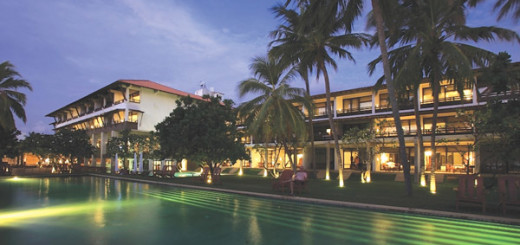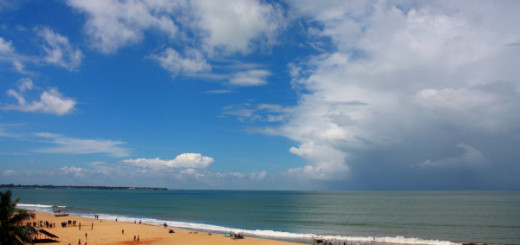Passikudah Reef and the Attractions of the East Coast
by Jetwing · Published · Updated
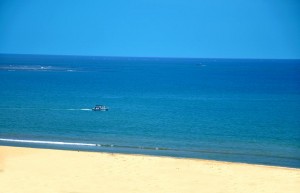 Passikudah is known to have one of the longest stretches of shallow coastline in the world. People walk kilometers into the sea because the water is only a few inches deep and the current is relatively weak compared to the rest of Sri Lanka’s coasts.
Passikudah is known to have one of the longest stretches of shallow coastline in the world. People walk kilometers into the sea because the water is only a few inches deep and the current is relatively weak compared to the rest of Sri Lanka’s coasts.
Attractions include the Passikudah Reef and the Mushroom Reef which boast diverse coral rife, shoaling fish and rock fish. The reef system is considered one of the best in the East and much of it remains largely unexplored. It consists of large inverted coral domes and very healthy coral life can be clearly seen.
Located at the southeastern edge of Passikudah Bay. Starting close to the surface the reef drops sharply to a sandy bottom at around 8m. There is good hard coral growth with some soft corals and the reef is home to a variety of small fish such as damselfish, cardinalfish, butterflyfish and small groups of snappers and sweetlips. The sandy area can be productive for finding shells, sand perches, shrimp gobies and other unusual fish species. A good place for night diving.
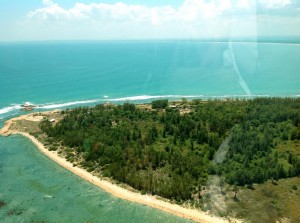 For more steadfast divers the East Coast offers some of the best deep sea diving experiences in Sri Lanka including the remnants of the HMS Hermes (95) the world’s first ship to be designed and built as an aircraft carrier. In World War II, after the raid on Colombo on 5 April by the Japanese, the Hermes was attacked on 9 April around 9 nautical miles (17 km) off Batticaloa. Also off the shores of Batticaloa is the Boiler wreck, ideal for less experienced but keen deep sea divers. The Marrakkala Gala, a beautiful surfacing rock formation is covered in hard corals, soft coral and sponges of all shapes, sizes and colors. It’s a great underwater landscape with spectacular balance of color in corals and marine life. There are several islands within the Batticaloa Lagoon such as Puliayantheevu, Buffaloa Island, and Bone Island. Many bridges have been built across the lagoon connecting the landmasses and the islands. The biggest bridge of all is Lady Manning Bridge located at Kallady.
For more steadfast divers the East Coast offers some of the best deep sea diving experiences in Sri Lanka including the remnants of the HMS Hermes (95) the world’s first ship to be designed and built as an aircraft carrier. In World War II, after the raid on Colombo on 5 April by the Japanese, the Hermes was attacked on 9 April around 9 nautical miles (17 km) off Batticaloa. Also off the shores of Batticaloa is the Boiler wreck, ideal for less experienced but keen deep sea divers. The Marrakkala Gala, a beautiful surfacing rock formation is covered in hard corals, soft coral and sponges of all shapes, sizes and colors. It’s a great underwater landscape with spectacular balance of color in corals and marine life. There are several islands within the Batticaloa Lagoon such as Puliayantheevu, Buffaloa Island, and Bone Island. Many bridges have been built across the lagoon connecting the landmasses and the islands. The biggest bridge of all is Lady Manning Bridge located at Kallady.
Further up along the coast in Vakarai and Kayankerni coral reefs boast a dazzling array of coral species and growth forms including marine life. The reefs have a great diversity of coral species with large coral domes, table corals and branching corals. The rich bio-diversity includes Butterfly fish, Angelfish, Surgeonfish and Parrotfish with Deep rocky reefs – covered in both hard and soft corals with larger fish like Sweetlips and Schooling Snappers. Large Gorgonian Sea Fans also reproduce in areas around Foul Point and Vakarai.
Another famed diving experience would be the Lady McCullum wreck – The Lady McCullum was a steam driven transport ship that floundered in 1926 while on a voyage from Trincomalee to Kalkudah. It now stands upright on a sandy bottom at 17m with parts of the wreck coming up to 10m. In addition, The Gladys Moller – A British transport ship floundered on the shallow Bakers Rock in front of Passikudah in 1942. The wreck is in very shallow water with a maximum depth of 10m. 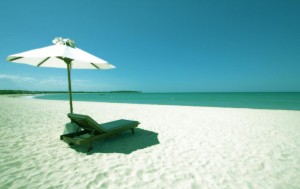
Adding to this bevy of marine resources also easily accessible in the region are the key towns of Trincomalee, Polonnaruwa, Minneriya, Habarana, Giritale and Dambulla. They too offer opportunities for many an interesting excursion including archaeological excursions in Polonnaruwa, Whale watching in Trincomalee, the Minneriya National Park, and the Sigiriya Rock Fortress etc. One of the latest attractions in Trincomalee is the Eagles’ Golf Links Golf course owned and maintained by the Sri Lanka Air Force, the Eagles golf course adorned with its lush green fairways in the distant corner of China Bay, is a few kilometers off Trincomalee. The fairways extend down from par 3 to par 5. The challenges are spiced up with water hazards, sand bunkers, roughs and of course doglegs left and right.
Travelling to Passikudah takes approximately 6 hours by road. It is 292 km from Colombo and the roads have now been reconstructed and are in a very good condition for travel. One can also travel on the Intercity Train Daily on First Class and Second Class which is also a rather comfortable journey of approximately 6 hours.
Since the end of the war in 2009, the East is gearing up for development and growth as the Tourist Development Authority has earmarked 156 acres of land for development converting Passikudah into a Tourist Zone. It is expected that that there will be approximately 1000 star class rooms in Passikudah.
 Amethyst Resort’s rustic charm is complemented by the unique combination of three distinctive natural elements rolled into one. The clear blue waters of the stunning ocean framing golden sands, the lush, green mangroves providing cool shade, the delightful rippling of the gentle stream flowing by. Only Amethyst Resort has this beautiful blend of scenery to offer…it truly is the Gem of the East Coast.
Amethyst Resort’s rustic charm is complemented by the unique combination of three distinctive natural elements rolled into one. The clear blue waters of the stunning ocean framing golden sands, the lush, green mangroves providing cool shade, the delightful rippling of the gentle stream flowing by. Only Amethyst Resort has this beautiful blend of scenery to offer…it truly is the Gem of the East Coast.

